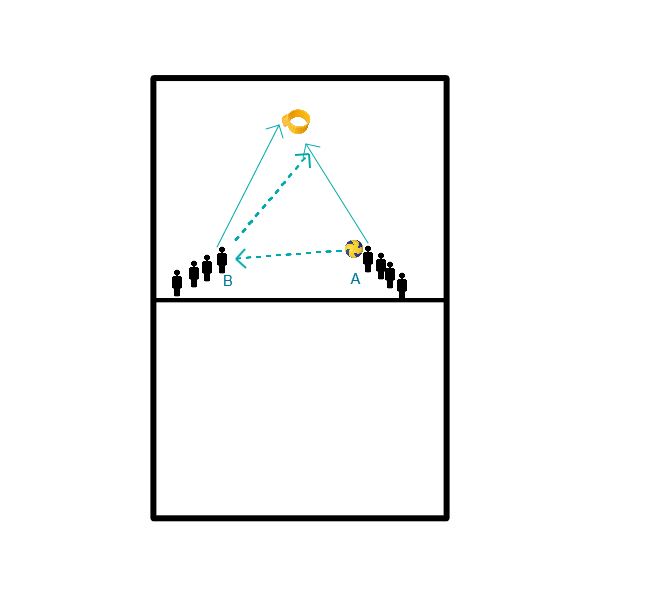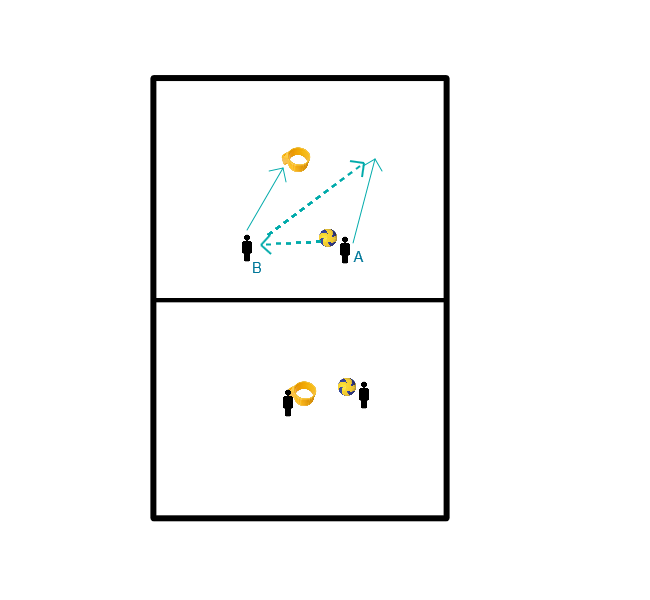Korfball drills
2 teams
per team 2 poles opposite each other and at 6 meter from the last pole a loose basket on the ground.
Small chance on 1st pole; run to 2nd pole with ball penalty throw; from this pole throw 3 balls exactly in the basket on the ground.
After 3 unsuccessful attempts you may continue to the next post.
When the 1st is at the 2nd pole, nr. 2 may start.
Variation:
- don't score with the ball but run around the post without the ball.
- Increase or decrease distance between last post and basket on the ground.
- So no 1 is at the 2nd pole no 2 at the 1st pole. no 2 throws in the hands of no 1. no 1 has to throw 3 balls in the basket on the ground. After that keep changing until everyone has thrown 3 balls in the basket.
- For one minute, one player is working
- That player stands at about 3/4 meter in front of the basket
- The receiver stands with the ball under the basket.
- The active player gets the ball and shoots, and then immediately walks to the back of the basket to shoot at 3/4 meter.
- Then shoot in front of the basket again, then to the back of the basket etc.
- After one minute, the active player changes from catch to shoot.
Start line-up
Two groups at the first two pawns.
Exercise
The first one in line runs to the basket lying on the ground and goes through it, so the basket goes over their head. Then he runs through the defence posture to pawn two and turns around it 4 times. Finally, he runs to pawn 3 and tries to score (3 attempts) before he can run back to pawn 1 and hit the next one in line.
Defensive stance:
Backwards and through the knees with your arm up.
Distance setup:
Hoop from pawn 1: 5 meters.
Pawn 2 from hoop: 5 meter.
Pawn 3 from pawn 2: 5 meter.
Pole from pawn 3: 4 meters.

Put a basket in front of each pair. Make sure they are lined up and that there is space on both sides for them to run through. Place a pawn at both sides at 8-9 metres.
- One of you starts under the basket with the ball, the other near the pawn.
- You run to the basket, get the ball and make a pass.
- Then you run to the next pawn to make another pass ball.
Continue until someone has scored a certain number or work with a time limit.
When this is the case, the declarer and the taker switch.
The handler must of course make sure that he has caught the ball again in time to signal the next pass.
At each basket stands one pair with ball. The shooter stands at 3 or 4 metres in front of the basket and there is a catcher under the basket. The ball starts under the basket.
- The pairs try to score 3 goals as soon as possible.
- As soon as one of the shooters has scored 3 goals, the team shouts YES.
- This means that all other pairs switch functions.
Scoring three goals earns your team 1 point. The game goes on, who has 3 points first.
- All players stand in a circle.
- Player A throws the ball to player B, and then runs to player B's spot.
- Player B throws the ball to player C, and stands on the spot of player C.
Start in a small circle (close to each other) and make the circle bigger and bigger.
Can be done in 2 groups, which group can stand furthest apart without making mistakes?
- The trainer sets up two (parallel) rows of an equal number of players evenly spaced apart.
- Both rows face a basket.
- The ball starts with a player under the basket.
- The person in charge plays a short pass to the first in line in front of him, the receiver catches the ball and turns around to pass it to the next in line.
- When the ball has reached the last player in line, he passes it back to the player 2 spaces ahead of him, etc., until the ball has reached the player in front of the basket, who takes a short shot.
- The shooter then takes the place of the declarer who then closes in behind as quickly as possible.
Variant:
- When the ball has reached the last in line (farthest from the basket), the declarer comes to support (high, depending on distance).
- The last player in line passes the ball to the attacker and starts a sprint for a walkthrough.
- The player is allowed 1 rebound attempt.
- A scored walkthrough ball is worth 3 points, a short shot 1 point.
The team that scores the most points wins. The teams learn to discover that the BALANCE between pace and precision is important. Those with pace are likely to get more chances, but those in a hurry pass inaccurately and may not finish the chances, requiring even more time. A fun game with a competitive element!
- The trainers have the children warm up in a fixed pattern (round or square).
- The children run behind each other with some distance between them.
- The child in front receives the ball from the trainer.
Variant 1
- While running, the ball is passed to the next person in line by means of a throw (short pass), the receiver passes the ball to the next person in line.
- The person in the back passes the ball back to the last thrower and the ball travels the whole route in reverse order.
- Emphasise technique where necessary and ask which form of passing is most effective.
Variation 2
- Similar to variation 1, but now the ball is passed backwards without looking (i.e. by feel).
- The emphasis now is on catching and uncatching the ball.
- The last player in line to receive the ball sprints with it to the front to start a new round.
- So there is always someone else in front.
Extension
: To make it a bit more difficult, you can appoint 1 or 2 defenders who make it more difficult to throw and try to intercept.
The trainer tells the children to warm up in a section or around baskets. It is important that the children don't run too fast, because it is warming up.
When the muscles are warmed up, the trainers can add variation to the exercise. At a 'Yes' or whistle signal from the trainer, the children must respond.
Variations you can introduce:
- Changing the direction of running
- Sprint for a few seconds
- Walk sideways
- Cross pass
- Tapping the ground (followed by jumping in the air)
Inshort: exercises in catching balls that bounce or roll at the right moment.
Organisation: each team has a ball and a basket.
- Three teams,
- the declarator stands in the middle under the basket.
- He rolls the ball a few metres away.
- As soon as the ball is loose, the other two may run.
- Who has the ball first, can make a turnaround or an attack with a pass?
- After 3 substitutions.
- Put a pole in the middle and divide your team in 2 groups.
- One group starts on the left, the other on the right (the right group (A) starts with the ball).
- Throw the ball to player B who stands left and walk directly to the basket for a walkthrough ball.
- You get this ball from the space of player B.
- Player B is going to catch.
As an alternative:
- You can start the ball at Player B.
- Throw to Player A and walk to the basket for support.
- Player A throws the ball to Player B and runs on for a walkthrough.
- See above but then Player A gets the ball for a walkthrough but does not take it but plays to Player B for a short chance. (Player B must then pull away).

Make two pairs.
- Start both at the front of the basket.
- Player A throws to player B and immediately runs a long line.
- Player B passes to the long line and goes to catch.
- Player A shoots, Player B catches.
Things to coach for:
- Make sure players are deflecting the long line toward the basket.
- Coach on throwing the long ball, make sure it is tight and arrives well.
- Try to shoot quickly so that your opponent is not right in front of you.
You can alternate this exercise by
- Don't let Player B catch the ball, but cut in for support.
- Let player A catch the ball first, throw it back immediately and then run the long line.
- Have Player B catch and then pull away for a short chance under the basket.








